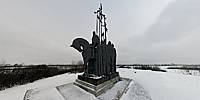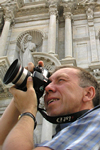
Monument on Top of the Hill
Sokolikha Hill, Pskov, Russia
20 March 2013, 09:19 UTC (13:19 local time)
© 2013 Andrew Varlamov, All Rights Reserved.
Go forward to the fork in the road and turn right. Walking on the shoulder along the guard rail You can see warrior's helmets looking like domes of the local Orthodox churches. Look to the southwest to compare the form of a helmet with the nearest church of Snetogorsky monastery.
The next left turn leads to a hill top. Sloping hillside is not long, but it is covered with ice today. The top step of the pedestal contains bronze plaque with the inscription "To Russian warriors, to the Great Prince Alexander Nevsky from grateful descendants". Now at close range it is possible to see that the prince on horseback wears scale armour, meanwhile warriors wear chain armour. Moreover, architectural ornaments of ancient Pskov decorate clothing and shields of warriors. Hemlines of chainmails decorated by elements of begunets (angled-brick) and soldier brick. The central parts of shields decorated with arched window openings, through which three shields together look like a three-nave church facade.
Despite not being built until 1993 after dissolution of the USSR, its construction was planned in 1967. The authors of monument project are sculptor Joseph Ivanovich Kozlovskiy and architect Peter Semenovich Butenko.
(RU) Проще всего добраться до вершины горы, где была снята эта панорама, можно, проехав на автобусе № 16 от железнодорожного вокзала Пскова до конечной остановки. Выйдя из автобуса, пройдите 50 метров вперёд до поворота дороги на Писковичи. Как только Вы пройдете под пятью жужжащими ЛЭП, справа от дороги покажется гора. На её вершине можно различить тёмные фигуры воинов с длинными копьями и флагами.
Пройдите вперёд до развилки дороги и сверните направо. Идя по обочине вдоль барьерного ограждения, можно увидеть шлемы воинов, похожие на купола православных церквей. Посмотрите на юго-запад, чтобы сравнить форму шлема с ближайшей церковью Снетогороского монастыря.
Следующий поворот налево ведёт на вершину горы. Пологий склон не длинный, но сегодня покрыт льдом. На верхней ступени постамента укреплена бронзовая табличка с надписью "Русским воинам, великому князю Александру Невскому от благодарных потомков". Теперь с близкого расстояния можно разглядеть, что князь на коне одет в чешую, а воины - в кольчуги. Кроме того, одежда и щиты воинов украшены архитектурными орнаментами древнего Пскова. Подолы кольчуг украшены элементами бегунца и поребрика. Центральные части щитов украшены арочными оконными проёмами, благодаря которым три щита вместе смотрятся как фасад трехнефной церкви.
Несмотря на то, что памятник был открыт в 1993 году после распада СССР, его возведение было запланировано еще в 1967 году. Авторами проекта памятника являются скульптор Иосиф Иванович Козловский и архитектор Петр Семёнович Бутенко.
Lat: 57° 50' 51.68" N
Long: 28° 16' 12.52" E
Elevation: 75 m
Precision is: High. Pinpoints the exact spot.
Lens: Samyang 8mm f/3.5 Aspherical IF MC Fish-eye
Panohead: Nodal Ninja Ultimate R10 mounted onto Manfrotto Monopod Quick Release Head 234RC
Pole: Fanotec Carbon Fiber Pole Series 2
Monopod: Gitzo GM3340L
Rotator: Fanotec Pole Rotator 45 degree stops
Pole Foot Plate: Fanotec F7155
PC Software: PTGui Pro 9.1.6 by New House Internet Services B.V. (dated by November 20, 2012), Pano2QTVR Pro Flash version 1.6.6 by Thomas Rauscher


 Tap or click the zoom icon in the bottom right corner of the picture to switch between in-page and fullscreen view
Tap or click the zoom icon in the bottom right corner of the picture to switch between in-page and fullscreen view